This seeded oat bread is crusty on the outside, chewy on the inside, and has the most delicious crunch in every bite, thanks to all the seeds. This is a hearty loaf that can stand up to any meal, from thick and chunky stews to delicate poached eggs. You’ll use an easy no-knead method to make this yeast bread, which produces a beautiful homemade loaf with minimal hands-on work.
This recipe is brought to you in partnership with Red Star Yeast.
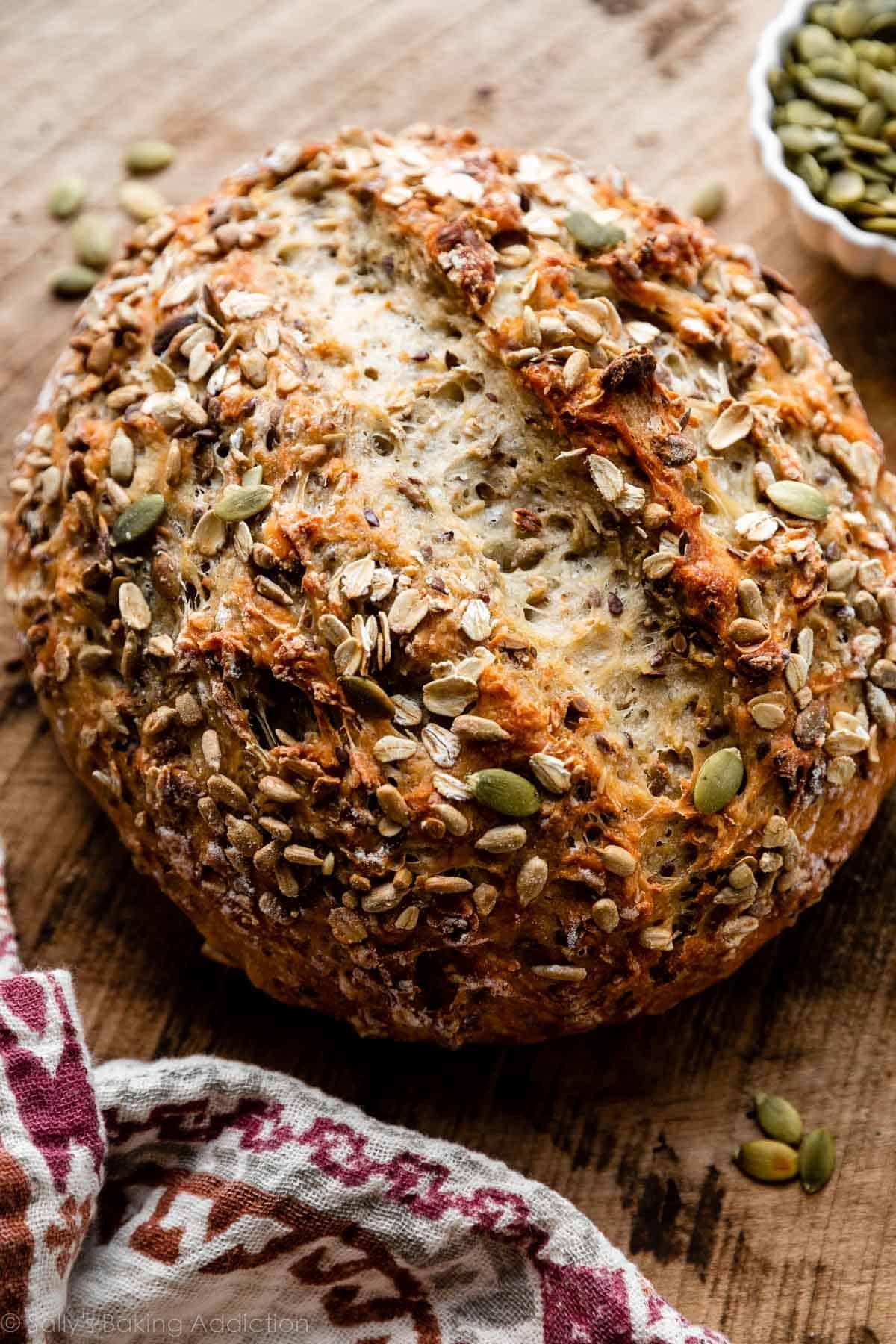
You know those gorgeous seed-encrusted loaves of bread you see in bakery windows?
The kind that look like they took ages to make, and you wonder how much kneading, shaping, and work went into just 1 loaf? Well, you can make those same beautiful seeded loaves right at home, with hardly any work involved. No kneading, no complex shaping, no mixer needed.
Yes, this crusty, chewy, golden-brown, seed-speckled oat bread doesn’t require any complicated work.
This bread, like my homemade cranberry nut bread and olive bread, will convince anyone that you either bought it from a bakery or spent all day in the kitchen making it—which, of course, you didn’t. Don’t feel like you have to let them in on our little secret. 😉
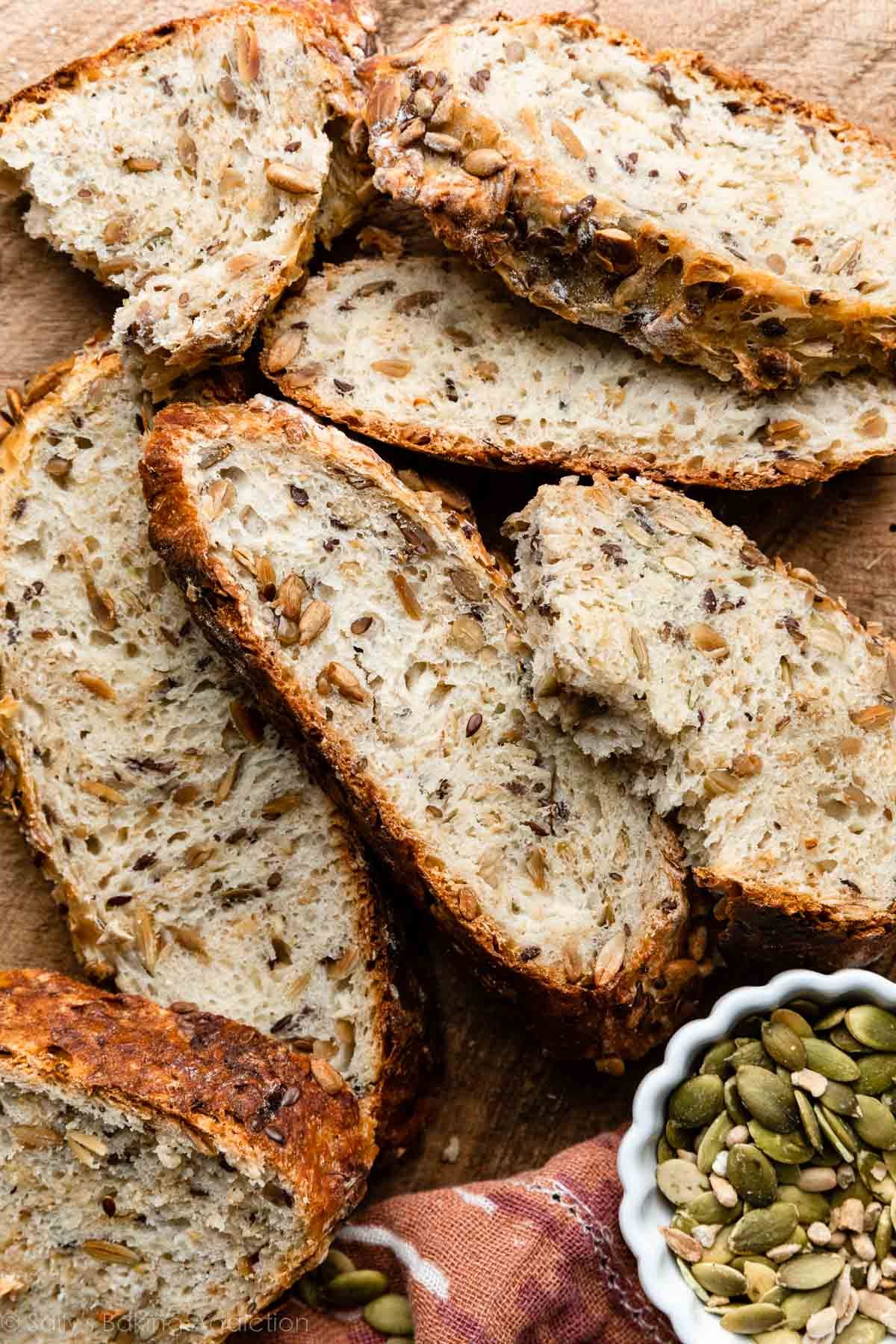
Hearty Homemade Bread for Beginners
This texture-lover’s seeded oat bread recipe is based off of my homemade artisan bread, a wonderfully easy and widely popular no-knead bread that’s used by both beginners and experts.
If you’re nervous to try homemade bread, this recipe is a great introduction. Even though the recipe is easy, the bread does NOT skimp on flavor. It’s just a simple way of baking homemade bread inspired by the no-knead technique originating from bread expert Jim Lahey.
Here’s why it’s so simple:
- Absolutely no kneading (just like homemade English muffins)
- Zero complicated shaping
- No mixer required
- 90% of the time is totally hands off
- Dough can rest in the refrigerator for up to 3 days—a great make-ahead recipe
- Can bake in a dutch oven or on a baking sheet
The trick is giving the risen dough a rest in the refrigerator. The cool air slows the fermentation process and helps develop better flavor.
Grab These Ingredients:
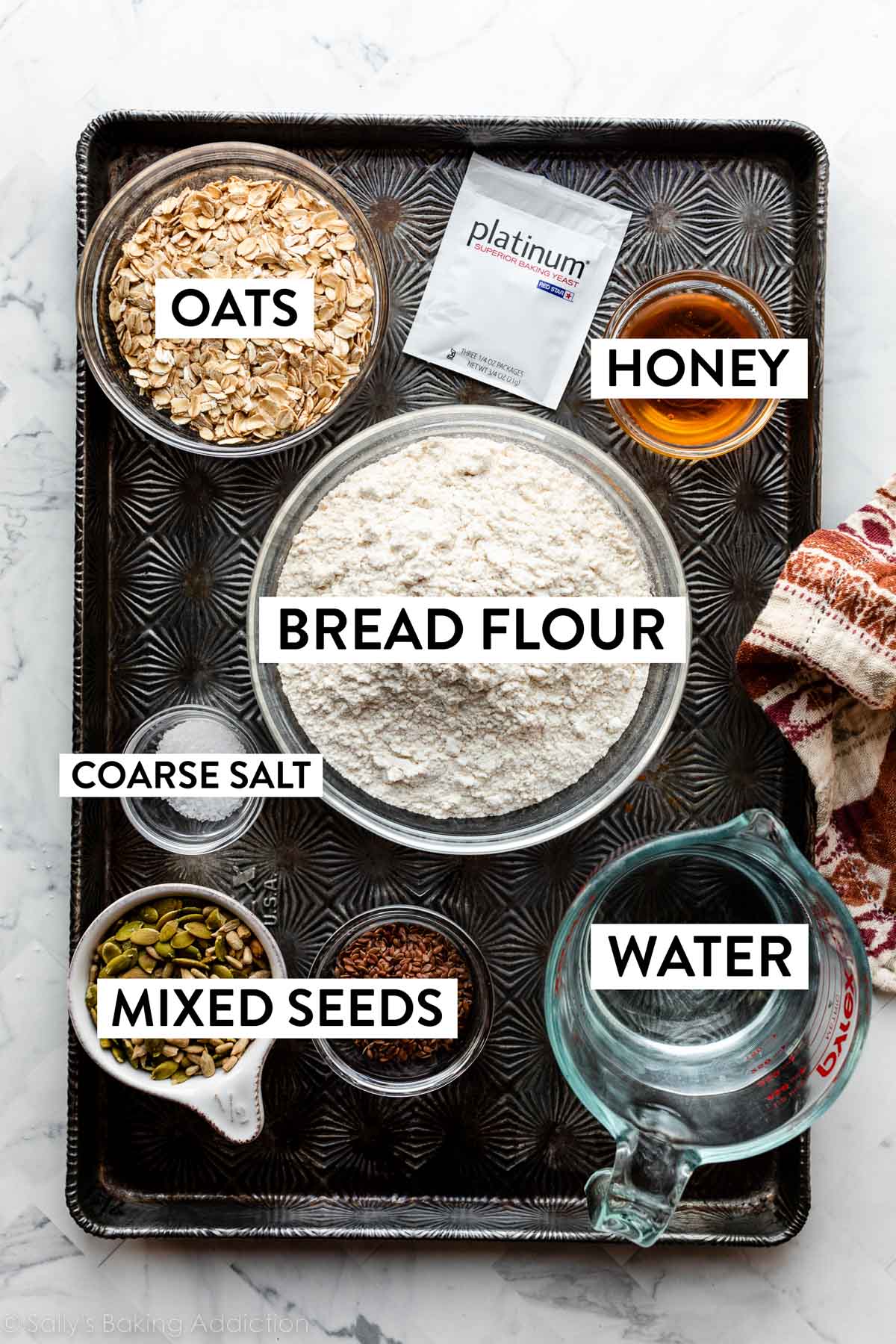
Here’s why each ingredient is so important:
- Bread Flour: While you could use all-purpose flour in this recipe, I strongly recommend using bread flour. Bread flour produces a stronger, chewier bread, and that makes a big difference in an artisan-style loaf like this oat bread.
- Oats: Oats provide a little wholesome texture. As the dough rises, the oats soak up some moisture and expand. Whole rolled oats are best, but you can use quick oats if needed.
- Salt: I recommend using coarse sea salt because I find the bread’s flavor lacking with regular table salt.
- Instant Yeast: I always use Platinum Yeast by Red Star, which is an instant yeast (aka “quick rise” yeast). 2 teaspoons is a little less than 1 standard packet. (If using active dry yeast, there are no changes needed to the recipe. The rise time may just take slightly longer.) I use more yeast in this recipe compared to my cranberry nut bread and jalapeño cheddar bread. Why? Those doughs rest and rise at room temperature. However, for more flavor and just as much rise, I use more yeast and let this dough rest in the refrigerator.
- Seeds: Pumpkin, sunflower, and flax seeds are all highly nutritious—they’re pretty much superfoods. I love that these 3 types of seeds vary so much in size and texture, but if you’d like to change up the types of seeds in this mixture, go for it. I use a medley of seeds in this multigrain bread, too.
- Honey: Honey helps give this bread a springy, spongey texture. It also adds a little sweetness, but we’re using half as much honey here than in my honey oat bread recipe, so the bread isn’t super sweet.
- Water: You’ll also need a little warm water to bring all the ingredients together. I use cool, room temperature water in olive bread and artisan homemade bread, two other no-knead doughs, but with the addition of oats today, the yeast has to work harder, and warm water helps it work quicker.
Let Me Show You How to Make This Seeded Bread
The full written recipe is below, but use the following explanations and step photos to help you get started. Bring the dough ingredients together as instructed in the recipe. At first the dough will seem very dry and shaggy and you’ll question if it will even come together. It will. In fact, the dough is a little sticky after it has been thoroughly mixed:
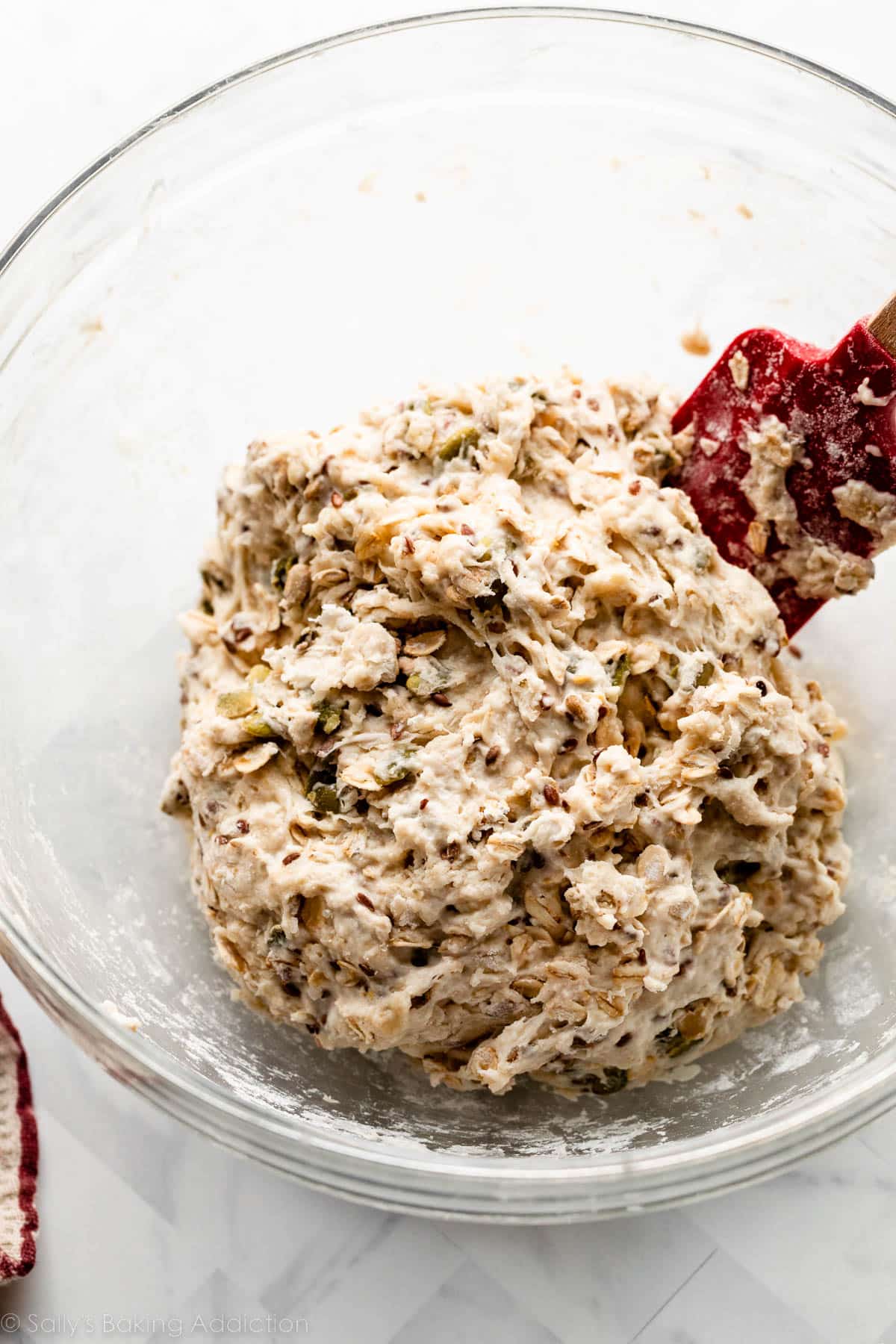
Let it rise. Cover the dough and let it rise at room temperature for about 3 hours. Notice that the dough rises OUT more than it rises UP. That’s ok.
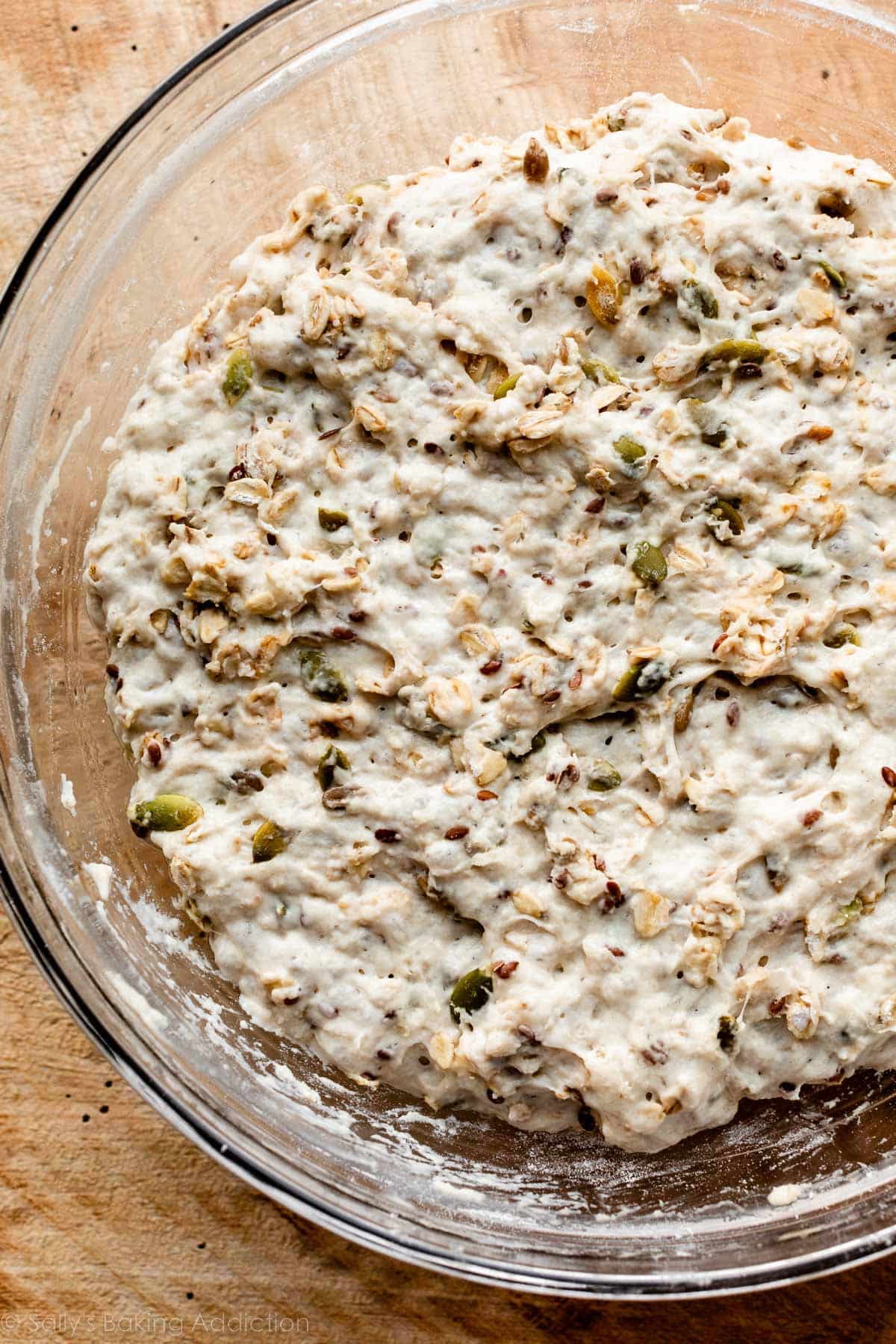
You can move on to shaping and baking the dough, but for best flavor, I strongly recommend refrigerating the risen dough, even if it’s just for a couple hours. I usually refrigerate it for 12 hours.
After the dough rises and rests in the refrigerator, use generously floured hands to shape the dough into a round boule or ball-like shape.
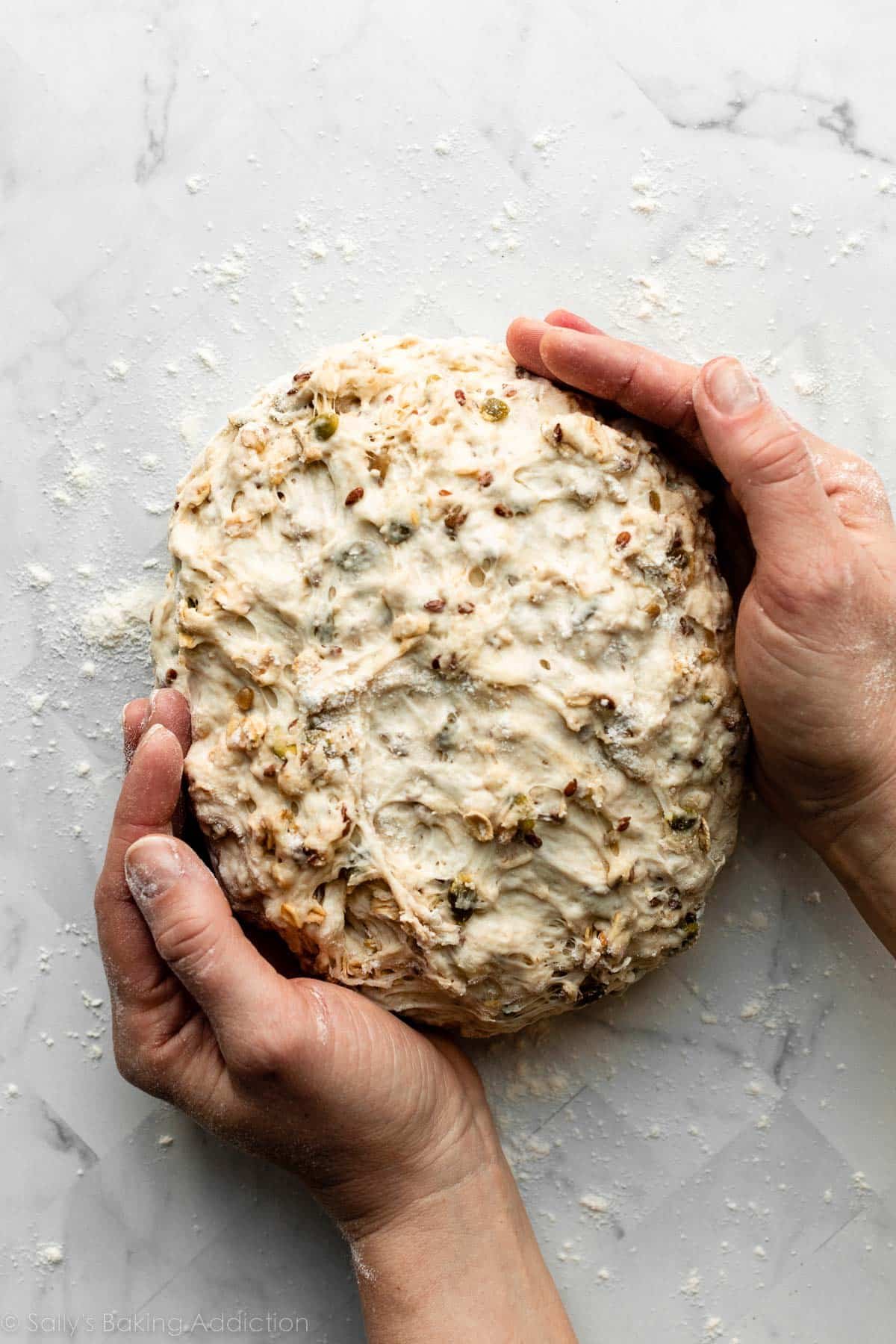
Use a Baking Sheet or Dutch Oven
Baking the seeded oat bread in a covered dutch oven traps steam inside the pot, creating that perfect crispy crust. If you plan to bake a lot of bread in the future, you won’t regret buying a dutch oven. If you don’t have a dutch oven, a nonstick baking sheet is best. (I use a baking sheet in the video tutorial below. And even have a trick for creating a steamy oven!)
- Baking Sheet: If you’re using a baking sheet, dust the pan with cornmeal and/or a little flour. Place the dough on top, cover it, and let it rest as the oven preheats. You will find these detailed instructions in the recipe below, along with my optional steamy oven trick for a crispy crust in step 10. (Adding boiled water to a pan beneath the baking bread. Works great!)
- Dutch Oven: Place the empty dutch oven with lid in the oven as it preheats. Place the ball of dough on high-heat-resistant parchment paper (I use this parchment paper), and then fit it inside a bowl. Cover and let the dough rest as the oven preheats, then place it (with the parchment) in the hot dutch oven before baking. You will find these detailed instructions in the recipe Note below.
Whichever baking method you use, don’t forget to add seeds/oats to the exterior of the dough (I usually just press them on). And make sure you score the dough with a bread lame or sharp knife before baking. Scoring allows the wet, airy dough to “breathe” as it expands and bakes.
Baking sheet method:
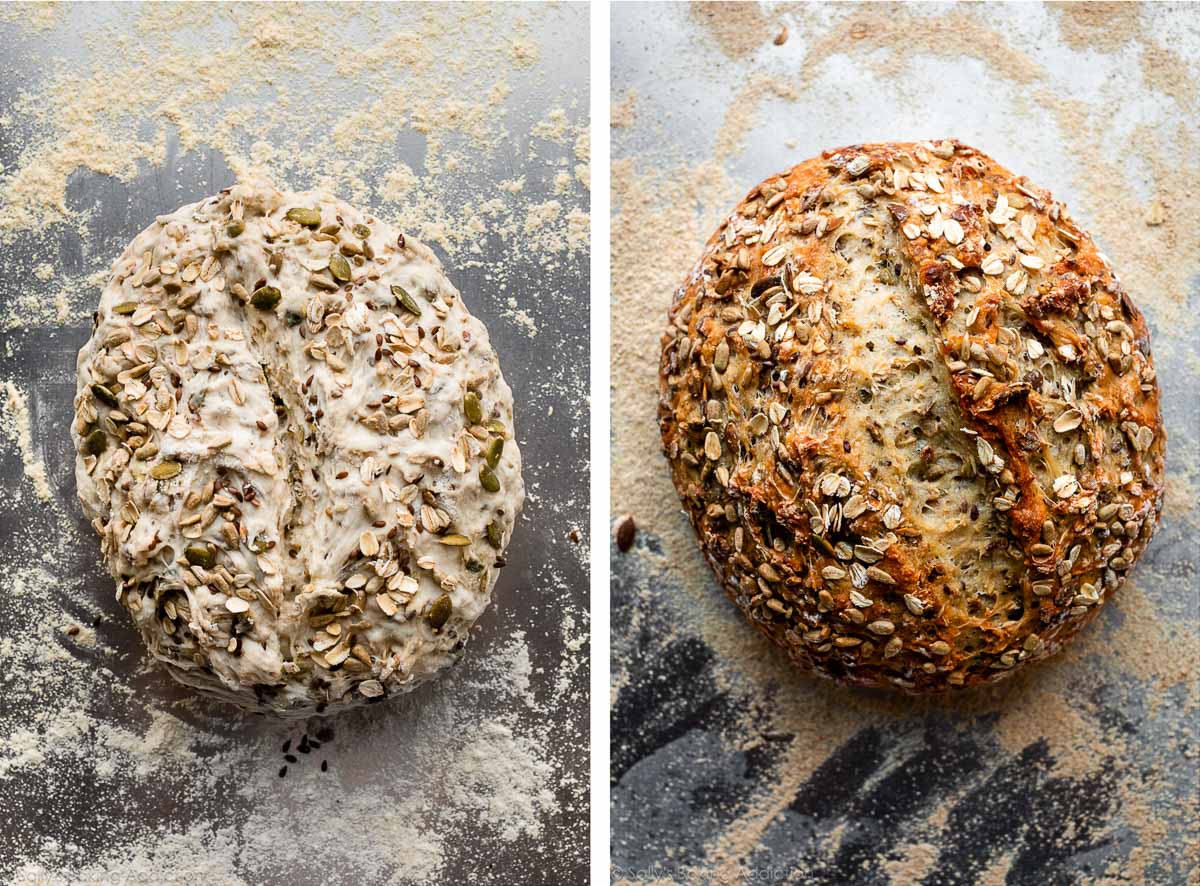
Dutch oven method:
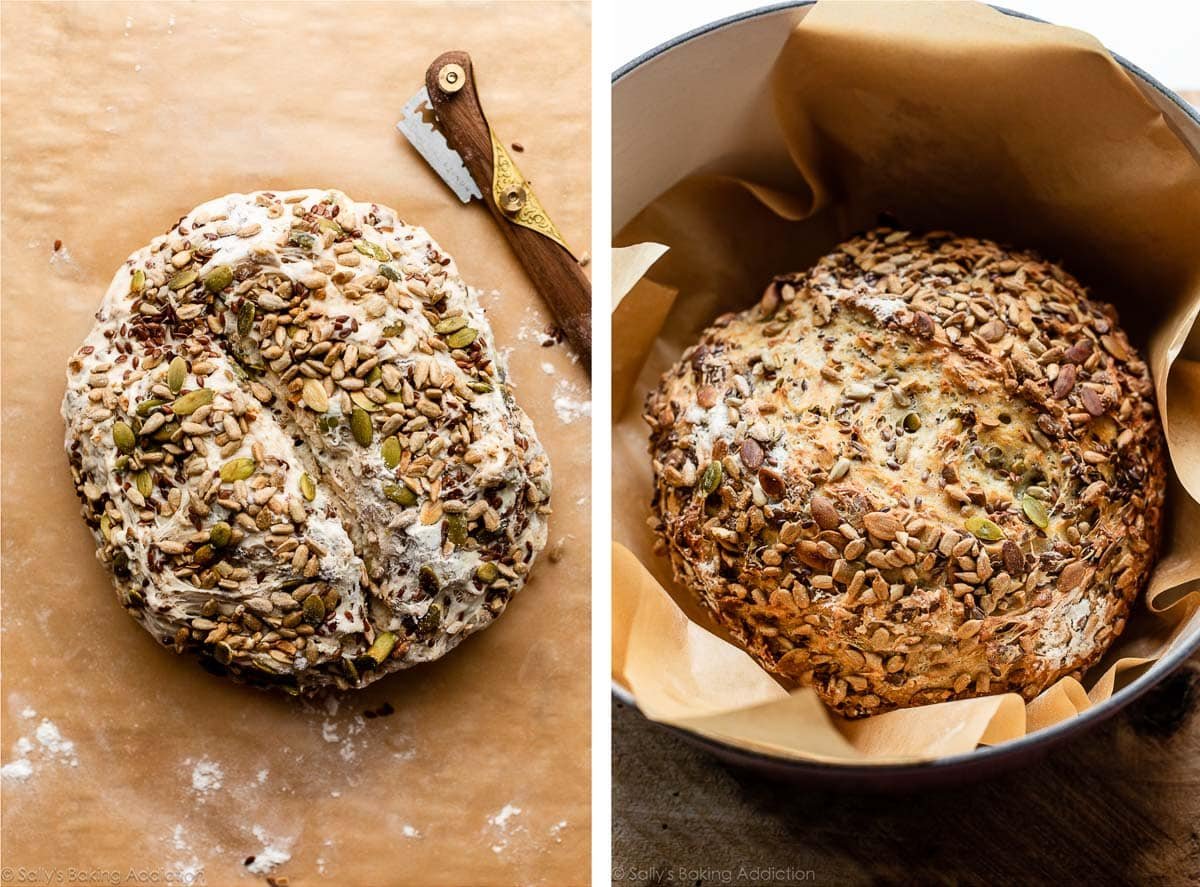
The bread is unbelievable when it’s fresh from the oven—warm, crispy, crusty, soft, and loaded with texture inside and out!
What Do I Serve With Seeded Bread?
Honestly, it’s fantastic plain, with a swipe of butter or a dip-dish of olive oil. The bread would also be delicious paired with homemade pesto or homemade honey butter.
But I especially love serving this seeded oat bread alongside a soup, like this creamy chicken noodle soup or homemade alphabet soup. It also gives phenomenal texture to grilled cheese sandwiches, and makes a hearty base for creamy smashed avocado and soft eggs.
If you manage to have any leftover, make use of the stale bread in this easy breakfast casserole!
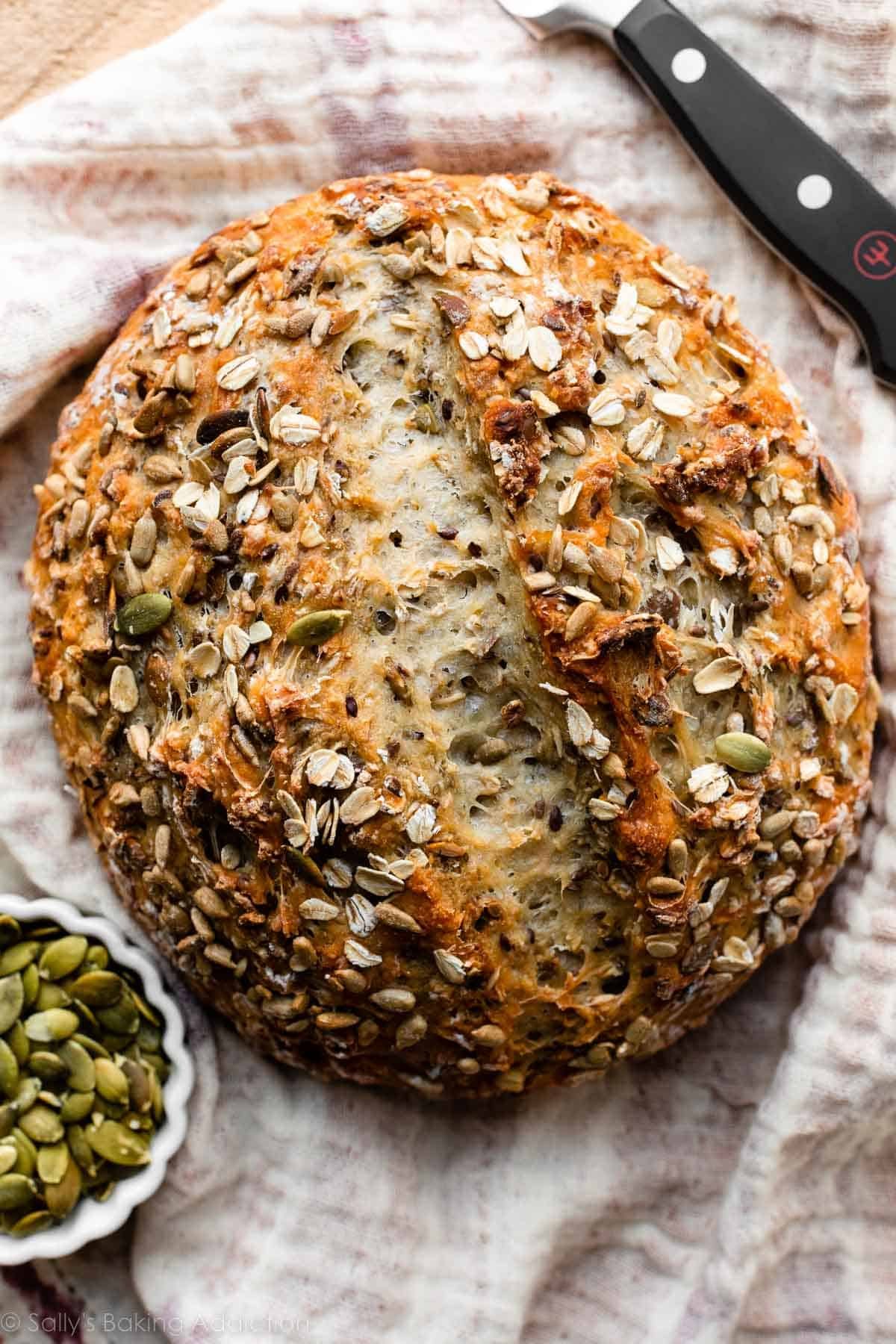
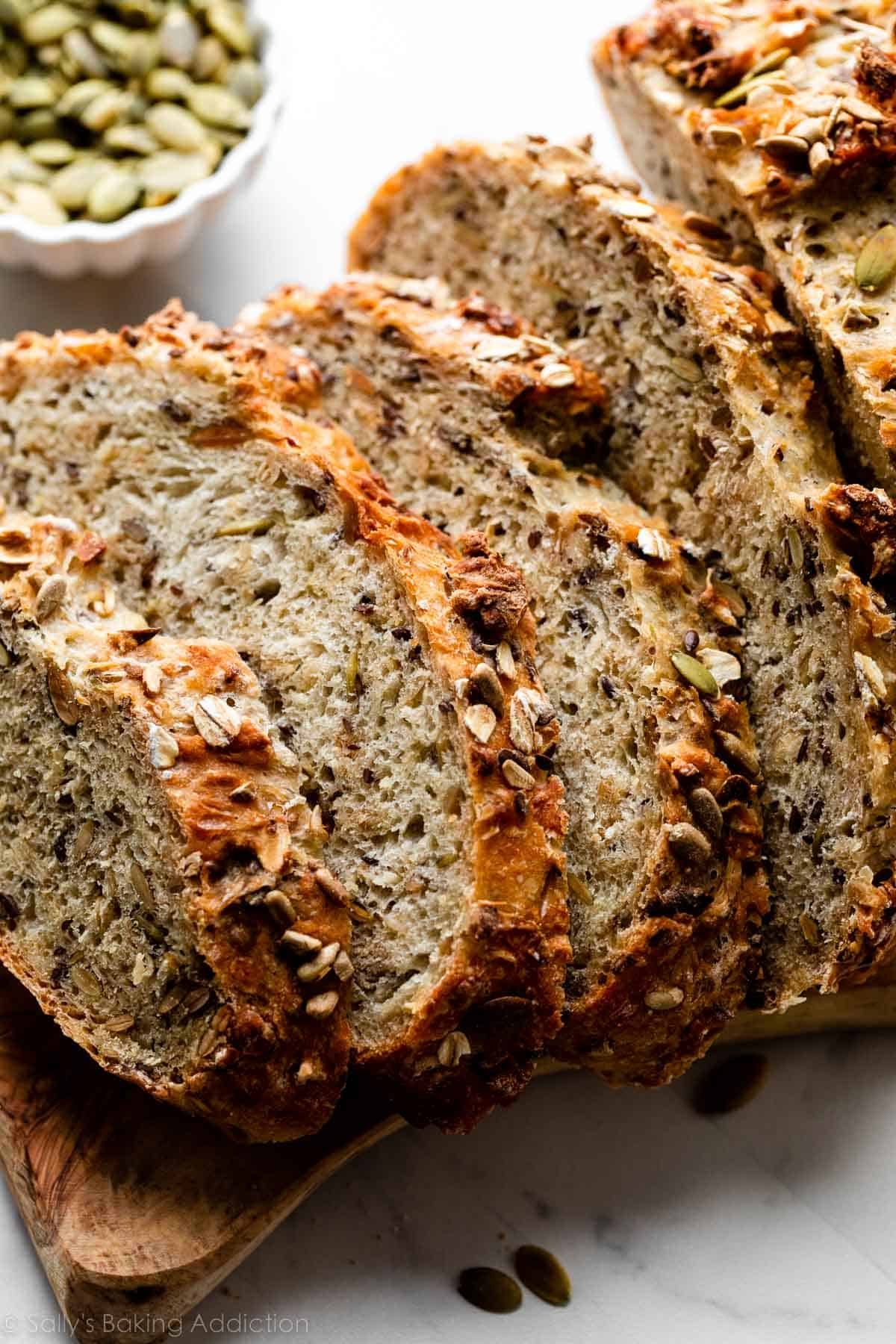
Yeast Bread Success Tips
If you’re a bread beginner, reference this Baking with Yeast Guide for helpful, easy-to-understand answers to many yeast FAQs. And/or get on the fast track to baking bread like a pro with my free Beginner’s Guide to Yeast email series.
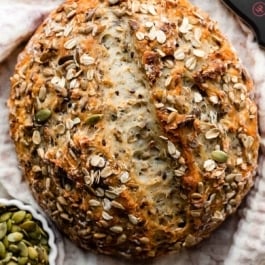
No Knead Seeded Oat Bread
- Prep Time: 4 hours
- Cook Time: 40 minutes
- Total Time: 5 hours (includes slight cooling)
- Yield: 1 loaf; 10-12 servings
- Category: Bread
- Method: Baking
- Cuisine: American
Description
Follow this easy no-knead recipe for a hearty loaf of homemade seeded oat bread. Review Notes before beginning. If you’re new to working with yeast, reference my Baking with Yeast Guide for answers to common yeast FAQs.
Ingredients
- 3 cups (390g) bread flour (spooned & leveled), plus more as needed for shaping and pan
- 2 teaspoons (about 6g) Platinum Yeast from Red Star instant yeast
- 1 cup (85g) old-fashioned whole rolled oats
- 1/4 cup (30g) unsalted pumpkin seeds (pepitas)
- 1/4 cup (30g) salted or unsalted sunflower seeds
- 2 Tablespoons (18g) flax seeds or sesame seeds
- 2 teaspoons coarse salt
- 2 Tablespoons (43g) honey
- 1 and 1/2 cups (360ml) warm water (about 95°F (35°C))
- optional: cornmeal for dusting pan
Topping
- 1 Tablespoon (5g) old-fashioned whole rolled oats
- 1 Tablespoon (8g) pumpkin seeds (pepitas)
- 1 Tablespoon (8g) sunflower seeds
- 1 teaspoon flax seeds or sesame seeds
Instructions
- Watch the video below before you begin, and let that be your visual guide for this recipe.
- In a large un-greased mixing bowl, whisk the flour and yeast together. Add the oats, pumpkin seeds, sunflower seeds, flax seeds, and salt and whisk to combine. Mix the honey and water together, and then pour over the dry ingredients. Using a silicone spatula or wooden spoon, gently mix together. The dough will seem dry and shaggy, but keep working it until all the flour is moistened. If needed, use your hands to work the dough ingredients together. The dough will be very sticky. Shape into a ball in the bowl as best you can. (Tip: Stir dough by hand. Dough is too sticky for a mixer.)
- Keeping the dough in the bowl, cover the dough tightly with plastic wrap or aluminum foil and set on the counter at room temperature (honestly any normal room temperature is fine). Allow to rise for 3 hours. The dough will just about double in size, stick to the sides of the bowl, and have a lot of air bubbles.
- You can continue with step 5 immediately, but for absolute best flavor and texture, I strongly recommend letting this risen dough rest in the refrigerator for at least 12 hours and up to 3 days. (Even just a couple hours is good!) Place covered dough in the refrigerator for up to 3 days. The dough will puff up during this time, but may begin to deflate after 2 days. That’s normal and nothing to worry about.
- Lightly dust a large nonstick baking sheet (with or without rims, and make sure it’s nonstick) with a little flour and/or cornmeal. Using generously floured hands and gentle pressure so as to not deflate the dough too much, shape the risen dough into a ball. (I just do this right inside the bowl it’s in, or you can do this on a lightly floured work surface.) Dough is very sticky.
- Transfer ball to prepared baking sheet. Mix topping ingredients together. Sprinkle on top of dough, and if the seeds aren’t sticking, press them into the dough as best you can. Loosely cover and allow dough to rest for 45 minutes. You will bake the dough on this prepared baking sheet. See recipe note if you want to use a pizza stone or dutch oven.
- During this 45 minutes, preheat the oven to 425°F (218°C).
- When ready to bake, using a very sharp knife or bread lame (you could even use kitchen shears), score the dough with a slash or X about 1/2 inch deep. (“Score” = shallow cut.) If the shaped loaf flattened out during the 45 minutes, use floured hands to reshape.
- Place the shaped and scored dough (on the flour/cornmeal-dusted pan) in the preheated oven on the center rack.
- Optional for a slightly crispier crust: Place a shallow metal or cast iron baking pan or skillet (I usually use a metal 9×13-inch baking pan) on the bottom oven rack. Carefully and quickly pour 3–4 cups of boiling water into the shallow pan. Quickly shut the oven to trap as much steam inside. The steam helps create a crispier crust.
- Bake for 40 minutes or until the crust is golden brown. If you notice the exterior browning too quickly, tent the bread with aluminum foil. How to test for doneness: Give the warm bread a light tap. If it sounds hollow, it’s done. For a more accurate test, the bread is done when an instant read thermometer reads the center of the loaf as 195°F (90°C).
- Remove the bread from the oven and allow to cool for at least 10–20 minutes before slicing and serving.
- Store leftovers loosely covered at room temperature for up to 3 days or in the refrigerator for up to 10 days.
Notes
- Make Ahead & Freezing Instructions: The dough can sit in the refrigerator for up to 3 days (step 4), so this is a wonderful recipe to begin ahead of time. You can also bake the bread, allow it to cool, and freeze for up to 3 months. Thaw in the refrigerator and allow to come to room temperature before serving. You can also freeze the dough. Complete the recipe through step 5. Wrap in plastic wrap and place in a freezer-friendly container. Freeze up to 3 months. To bake, allow dough to thaw overnight in the refrigerator, or for 2–3 hours at room temperature. Continue with step 6, including allowing dough to rest for 45 minutes before baking. Keep in mind that the bread tastes a little heavier after freezing/thawing the dough and then baking it.
- Special Tools (affiliate links): Glass Mixing Bowls | Silicone Spatula or Wooden Spoon | Baking Sheet | 2-cup Measuring Cup | Bread Lame | Instant-Read Thermometer
- Flour: For absolute best flavor and chewy texture, I strongly recommend using bread flour. You can use a 1:1 substitution of all-purpose flour in a pinch with no other changes to the recipe. I recommend avoiding whole wheat flour in this dough; however, if necessary, you can replace up to 1 cup (about 130g) of the bread flour with whole wheat flour. The bread will taste a bit heavy.
- Yeast: I always use Platinum Yeast from Red Star, an instant yeast. You can use any instant yeast in this dough. If using active dry yeast, the 1st rise time is usually slightly longer, about 3.5–4 hours. Reference my Baking with Yeast Guide for answers to common yeast FAQs.
- Salt: Use a coarse salt, such as coarse sea salt, in this bread. I find the flavor slightly lacking when using regular table salt. If you only have table or fine salt, reduce to 1 and 1/2 teaspoons.
- Seeds: Feel free to use more/less of a particular seed you love, or skip any seeds if you wish. Around 1/2 cup of larger seeds and 2 Tablespoons of smaller seeds is ideal. I usually use unsalted pepitas and salted sunflower seeds. Salted or unsalted are fine, but I don’t recommend 1/2 cup of salted seeds, so if you want to use salted, use 1/4 cup of salted and 1/4 cup unsalted. If you want to add poppy seeds, replace 1 Tablespoon of flax seeds/sesame seeds with poppy seeds. Or just use 1 Tablespoon poppy seeds and skip the flax/sesame.
- Using a Dutch Oven: You need a 6-quart or larger dutch oven or any large oven-safe pot with a lid. Prepare dough recipe above through step 4, including refrigerating the risen dough for at least 12 hours. After refrigerating, turn the dough out onto a lightly floured work surface and, using lightly floured hands, shape into a ball as best you can. Doesn’t have to be perfect. Transfer dough to a large piece of parchment paper. (Large enough to fit inside your pot and one that is safe under such high heat. I use this parchment and it’s never been an issue.) Lift the parchment paper and dough up and place it all into a large mixing bowl. Cover dough lightly with plastic wrap and leave alone for 30 minutes. During this 30 minutes, preheat the oven to 425°F (218°C). Place your dutch oven (with the lid) inside for 30 minutes so that it’s extremely hot before the dough is placed inside. After 30 minutes, sprinkle seed topping all over dough. Using a bread lame or sharp knife, gently score a 1/2-inch-deep slash or X into the top. Remove the dutch oven from the oven and carefully place the dough inside by lifting it up with the parchment paper and placing it all—parchment paper included—inside the pot. Cover with the lid. Bake for 30 minutes with the lid on. Carefully remove the lid and continue baking for 10 more minutes or until the bread is golden brown. You can test for doneness exactly how you would in step 11 above. Remove pot from the oven, carefully remove the bread from the pot, and allow to cool on a wire rack for 10–20 minutes before slicing/serving.
- Using a Pizza Stone: If you want to bake your bread on a pizza stone, place pizza stone in the preheating oven. Remove hot pizza stone, dust with cornmeal or a little flour, and then transfer shaped and scored dough to hot pizza stone and bake as directed.
- No Nonstick Pan? If you don’t have a nonstick baking sheet, line it with parchment paper instead. Coat with a dusting of flour and/or cornmeal before placing the dough on top. Parchment paper can burn, so it’s best to check the box to see how much heat yours can tolerate. Lower your oven heat if necessary, and bake the bread for longer until it’s golden brown and sounds hollow when tapped.


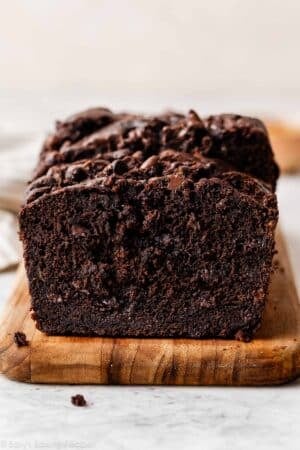
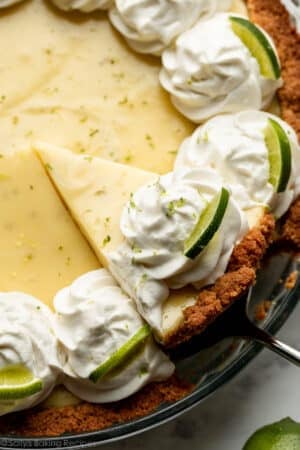









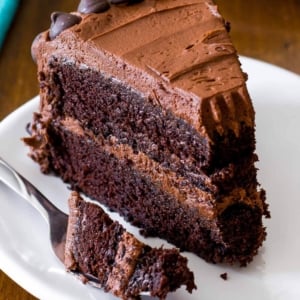




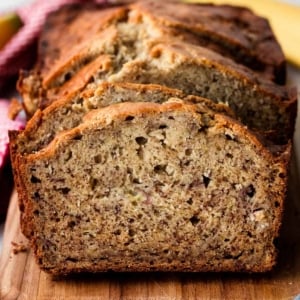
I’m not sure I’d make this one again. It was super easy, and the dense texture was exactly what I expected. However, it’s lacking in flavor for me. It’s definitely better toasted though. I think I’ll keep searching for a seed bread recipe
This is, by far, the best loaf of bread I have ever baked. I may give up my sourdough loaves from now on and start exclusively baking this seed bread. I got a good rise out of it, but after I put it in the frig overnight, it deflated somewhat and never bounced back. Next time, I think I will stick with a single-rise and bake it straight-away and see how it differs in height, as well as textures. Thank you Sally, this loaf rocks!
Just curious as I’m about to start would it affect the rise if I refrigerated it for overnight…longer than the 12 hours?
Hi Robyn, you can leave the bread to rise in the refrigerator for up to 3 days.
Robyn, this is an excellent recipe. However, when I refrigerated overnight, I lost about half of the “rise”, and it never bounced back after I took it from the frig, nor even after baking. Next time I will try doing only one rise and then straight into the oven and see what happens. But it’s definitely the most delicious bread I’ve ever made. Best of luck!!
I made this and loved how easy it was.
I was just wondering if you used roasted pumpkin and sunflower seeds or raw?
Hi Kerry, We typically use raw, but you can use roasted seeds if desired.
This was so easy and so delicious!
I used my Dutch oven.
I live in Canada, Is Platinum Yeast from Red Star instant yeast, the same as quick rising yeast?
Quick rise and instant yeast are the same – happy baking!
Sorry, one more thing, I did refridgerate it for 18 hours. Wasn’t as big as your cranberry nut loaf. Should it have been?
The dough should grow to about the same size, yes. It can fall a bit if refrigerated for a long time. This is not a problem, though!
Hi Sally I made your cranberry nut no knead bread and my mother flipped out on it. After I saw Costco was selling a similar bread for $9, I said, “no way…I’ll make my own.” That’s how I found you! Then I made the no knead seeded_nut bread and it came out much smaller and heavier. My husband loved it. I thought it turned out not quite right. Wondering if I did something wrong. I’ve been making bread for quite a few years. Thoughts?
Hi Deb! The doughs are similar, but this seeded oat bread is more dense. So glad you’re enjoying making your own bread at home!
Mine wasn’t great,weighed everything too. Not sure if it was too cold during initial 3hr rest time,old flour absorbed more of the water.. will give it another go.
Just so that you know that to date, I’ve made more than 15 loaves of this simple no-fuss & guaranteed to turn out bread. ❤️Thanks for sharing this great recipe. The family loves the bread but I wondered if I could make it less dense.
Hi Shirley, we’re so glad this is a favorite for you! This is a denser bread and not expected to be light inside, due to the oats and seeds packed inside, plus the no knead technique. Make sure to handle the dough with care after it rises to maintain all the air bubbles inside.
What can I use instead of bread flour or all purpose flour ? Can I use almond flour or any other gluten free flour
Hi Shanthi, we haven’t tested a gluten-free version, so we’re unsure of the results. Although some readers report using an all-purpose 1:1 gluten-free flour in many of our recipes with success, you should expect slightly different results anytime you substitute ingredients. Let us know if you give it a try.
Is it ok to fold the dough as in other bread recipes?
Hi Robert, You can use your hands to bring the dough together, but after it rises you do not want to knead or fold it so that it doesn’t deflate.
I made this recipe today but put it in a loaf pan because I thought it would be easier to toast in that size. I also modified the recipe by using 2.5 cups of bread dough and .5 cup whole wheat flour. I left it in the refrigerator for about 18 hours. I baked it at 375, as recommended, for 45 minutes, which is when it reached 195 degrees. It turned out wonderfully! I think it may have tasted even better than the first time I made this, and it should be perfect in the toaster. This is a great, easy recipe. I did have a little trouble getting all the seeds to stick on the top, but I think I just didn’t do a good job in pressing them into the dough. Thanks for this great recipe and your willingness to offer modification suggestions!
I made it today for the first time. I left the dough in the fridge overnight and it came out amazing. Thank you for the recipe.
Delicious! Exactly what I was looking for.
Love the recipe!! Can this be made with wholemeal flour? And if yes, do I need to adjust anything?
Hi Diana! See recipe note — we recommend avoiding whole wheat flour in this dough, however if necessary, you can replace up to 1 cup (about 130g) of the bread flour with whole wheat flour. The bread will taste a bit heavy.
Made this bread today for the 1st time and it was amazing! Followed directions to a tee and it came out perfect and was delicious! Will definitely be making this on a regular basis. Thanks so much for sharing such a wonderful and easy to make recipe for us newbie bread bakers!
My dough looked perfect and matched all your photos until I baked it. It rose beautifully the first rise and I put it in the fridge for 14 hrs. Let it sit for 30 min, put it in my heated dutch oven and it did not rise at all once baked. What happened?
Hi Sandy! The dough won’t rise much when baking, it’s a denser bread! The air bubbles come from the long rise – make sure to handle the dough with care to prevent them from getting popped.
I look forward to giving this one a try. I was wondering might I be able to add rye flour okay with this recipe and if so, how much would I replace of the bread flour to rye ratio. Thank you for your assistance.
We haven’t tested that, Karen. Let us know if you do!
This recipe takes some planning ahead but well worth it. It’s so good and hearty. I also made the Honey Butter to go with it.❤️
Made this and it is delicious! Used a package of active yeast and let it rise for 4 hrs instead of 3 hrs, and then put in the fridge overnight as recommended. Cooked it using the Dutch oven method and it turned out perfect!
Would the addition of a bit more honey affect the rise/structure? Also did you use roasted flax or just regular flax seeds? Thanks.
Hi Crystal! A bit more honey should be fine. We usually use regular flax seeds. You may also enjoy our no knead honey oat bread.
Please tell people that the pizza stone should not be removed from the oven while hot. That could be very dangerous. Loading the prepared dough onto a parchment covered peel or even the back of a cookie sheet then sliding onto the stone is safer.
This bread looks so good, thanks for sharing the recipe! Is this something I could make using sourdough starter instead of yeast? If so, how would I go about it?
Hi Malu, we haven’t tested this recipe using a sourdough starter, but let us know if you do any experimenting.
Such an awesome recipe. I have made many loafs and all are perfect. Recently I was in a hurry and did not do the refrigerator rise, but instead added 1TB of my sourdough started when mixing it all up. Turned out great! Thank you for this recipe
I have a dome bread baker. Do I need to preheat prior to adding the dough to bake
Hi DeAnn! If you typically preheat it, we would preheat it here as well.
Do you use roasted or soaked seeds in this recipe? I have raw pumpkin and sunflower seeds, can I just use them raw?
Hi Ingrid, you can use your raw seeds here, not a problem.
Thanks for replying so quickly! I can make it today!!